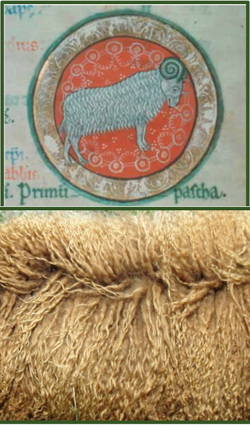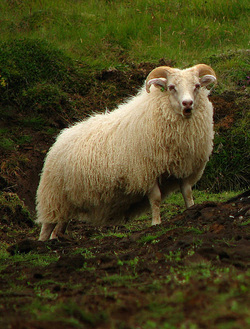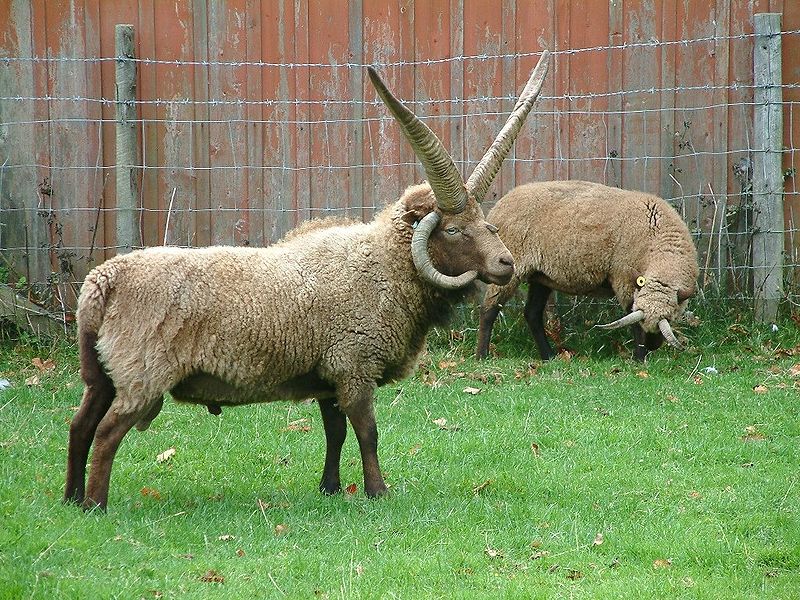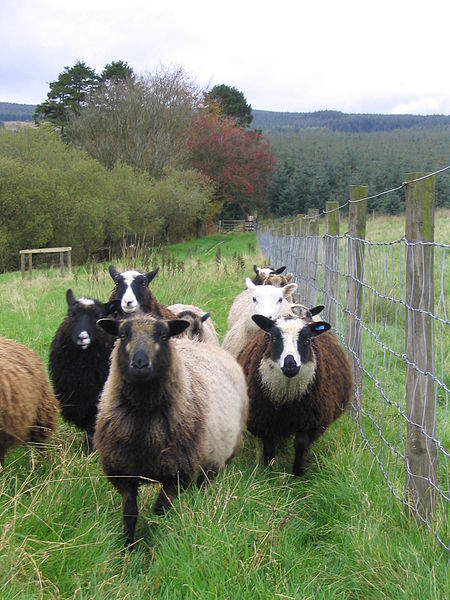 Image from the York Psalter and an Icelandic fleece
Image from the York Psalter and an Icelandic fleece Because the most common fabric found in archeological digs is wool, I wanted to use the most period fiber possible when I began spinning and weaving to better attempt to recreate items from the past. This led me to begin a more in-depth research on which modern sources of wool would be the closest to that which was used in period. The information I have gotten on the subject is far more vast, and decidedly less simple, than I expected when I began this journey.
Sheep are one of the oldest domesticated animals, dating back to the Fertile Crescent in 9000 BC (Orsted Brandt, 20). Many researchers believe that the breeds of sheep in Northern Europe have a common ancestor in the Wild Mouflon sheep (which still exists as a feral species in some areas today). Evidence of faunal remains from early settlements shows that sheep and goats have been present in Scandinavia since Neolithic times. (Jennbert, 161)
Valued as producers of milk, meat, wool and pelts, the Norse raised sheep and spread them across Northern Europe from the late 8th to the middle of the 11th century. These Viking sheep were the predecessors of the modern Northern European Short-tailed group. (Dýrmundsson and Niznikowski, 1276) Included in this modern classification are the Norwegian Spelsau, Gotland, Finnsheep, Icelandic and many others.
To be classed as a Northern European Short-tail, a sheep will, of course, have a short tail (8-10 vertebrae compared to 16-18 in other groups). In addition to that common trait, they also tend to have dual coats, legs with only short hair, a range of colors and patterns, and they tend to be hardy even in harsh climes. Additionally, they can be polled or horned, or with rams only bearing horns. (Dýrmundsson and Niznikowski, 1276) In addition to these features, the most primitive of these breeds have still retained the ability to shed or moult. (Ryder, Survey, 381)
Many of these breeds have been “improved” over the centuries, but some, such as the Old Norwegian Sheep, which is thought to be one of the oldest of the breeds, and others, such as the Icelandic sheep, have had less, or in some cases, no additional genetic strains added to improve their bloodlines. (Dýrmundsson and Niznikowski, Table 2) Despite lack of additional bloodlines introduced, these sheep, M. L. Ryder, an authority on the archaeology of sheep and wool at the Wool Research Association in Edinburgh, are “imperfect living fossils” because selective breeding has still often adapted them to what their farmers desired of them. (Ryder, Sheep & Man, 759) Often breeding stock is chosen for better wool, more meat production, parasite resistance, etc., and this changes the breed over time.
The small Soay sheep (often classed as a Northern European Shorttail, but sometimes classified as an even older breed, while still being related to the North European sheep) has been determined to be closest to their prehistoric ancestor, the Mouflon. Despite that close genetic connection, these petite sheep have wool that is less hairy than it was in antiquity. (Ryder, Medieval Sheep, 19) One of the most surprising facts I have learned during my study of ancient wool is that during domestication, the the outer coat of kemp (very coarse, brittle hairs) on the earliest sheep evolved into a less course hair, while the under wool actually became more coarse during this evolutionary process. Ryder states that “Few, if any, domestic sheep have wool as fine as that of a wild sheep.” (Ryder, Survey, 385) The process of breeding for better wool and a higher volume of wool actually reduced the quality of the finest fibers the animal generates while allowing for more wool overall to be produced.
 Icelandic Sheep by Wellington Grey from London, England
Icelandic Sheep by Wellington Grey from London, England There are 34 short-tailed breeds today (descendants of the sheep spread across Europe by the Vikings), including some that are exceptionally rare or even endangered. I am collecting wool samples from those that I can locate and have constructed a series of cards with whole locks and spun samples of each that I display at events. I will be adding photos of each to this blog, along with information about the animals themselves, as I compile my research.
Because each of these modern breeds is quite distinct, the wool types can range from soft to coarse, short to long, and from straight to very curly (it can even vary within a breed or on a single sheep).
So far, I have learned that despite not being able to find a “perfect” period sheep, I can choose to use wool from these more isolated animals (when available), and that will allow me to make a better attempt at reproducing items for my chosen period. To do this, I often look for fleeces from among the more primitive short-tail breeds. Those animals that have the coats that moult and that tend to be colored rather than white are particularly appealing to me. They are evolutionarily closer to the sheep of the ancient Norse travelers than many of the modern breeds today. (Ryder, Sheep & Man, 765)
Because Icelandic wool is easily accessible in the U.S. and because it is one of the breeds least tampered with over time, I often chose to work with it for my projects. I also have a good quantity of Shetland, Spælsau and Gotland on hand for spinning and weaving. Beyond the interesting historic aspects of these fleeces, most wool that I have purchased comes from smaller heritage farms and I enjoy being able to support the farmers' efforts to conserve these historic breeds.
Do we, as reenactors, have to use the most period fiber possible? Of course not. We are often limited by finances or availability of certain types of fleece. I think a handspun, handwoven garment can be just as nice when crafted from a purely modern breed and it is not uncommon for a spinner to be gifted large amounts of random wool. Given that I am a huge proponent of UWYH (Use What You Have), I think that the quality of the work can stand on its own regardless of fiber type. I do, however, believe that it is important to make the attempt to understand what wool was like (and the animals that grew it) in historic times and when the situation allows, using the best wool possible.
| Northern European Short-Tailed Sheep Breeds Alans Island Sheep – Finland Åsenfår Sheep – Sweden Boreray Sheep – Scotland Castlemilk Moorit Sheep – Scotland Dala Fur Sheep – Sweden Faeroe Sheep – Faeroes Finnsheep – Finland German Heath Sheep – Germany Gestrike Sheep – Sweden Gotland Sheep – Sweden Grey of Kainuu Sheep – Finland Hebridean Sheep – Scotland Helsinge Sheep – Sweden Icelandic Sheep – Iceland Klövsjö Sheep – Sweden Manx Loaghtan Sheep – England North Ronaldsay Sheep – Scotland Norwegian Pelt Sheep (Pelssau) – Norway Norwegian Speal Sheep (Spælsau) – Norway Old Norse Sheep (Villsau) – Norway Old Speal Sheep – Norway Polish Heath Sheep – Poland Romanov Sheep – Russia Roslag Sheep – Sweden Russian Viena Sheep – Russia Rya Sheep – Sweden Shetland Sheep – Scotland Skuddy Sheep – Germany Soay Sheep – Scotland Svårdsjö Sheep – Sweden Swedish Finewool Sheep – Sweden Ushant Sheep (Ouessant) – France Värmland Sheep - Sweden Related breeds: Herdwick - England (Dýrmundsson and Niznikowski, Table 1. Note that Ryder classifies the Polish Heath Sheep and the German Heath Sheep are classified separately with the Drenthe Sheep of the Neatherlands and the Ushant Sheep are classified in a south western group). |
- The Fleece and Fiber Sourcebook: More Than 200 Fibers, from Animal to Spun Yarn by Carol Ekarius and Deborah
- Sheep & Man by M. L. Ryder (This book is out-of-print but is available in the U.S. via ILL.)
References:
- Dýrmundsson, Ólafur and Niznikowski, Roman. “North European short-tailed breeds of sheep : a review,” 59th Annual Meeting of the European Association for Animal Production. 2008
- Jennbert, Kristina. “Sheep and Goats in Norse Paganism”, Pecus, Man and Animal in Antiquity: Proceedings of the conference at the Swedish Institute in Rome, September 9-12, 2002. Ed Barbro Santillo Frizell, 2004.
- Orsted Brandt, Luise, et al. “Characterising the potential of sheep wool for ancient DNA analyses”, Archaeol Anthropol Science, 2011.
- Ryder, M. L. "A Survey of European Primitive Breeds of Sheep," Annales de Génétique et de Sélection Animale. 13, no. 4: 381−418, 1981.
- Ryder, M. L. “Medieval Sheep and Wool Types.” Agricultural Review, Vol. 32, No. 1, 1984
- Ryder, M. L. Sheep & Man (Gerald Duckworth & Co.), 1983.
- Walton, P. "Textile Production at 16-22 Coppergate." The Archaeology of York Volume 17: The Small Finds. 1977.
Coming soon: Information and fiber samples of various breeds from the Northern European Short-tailed group.




 RSS Feed
RSS Feed